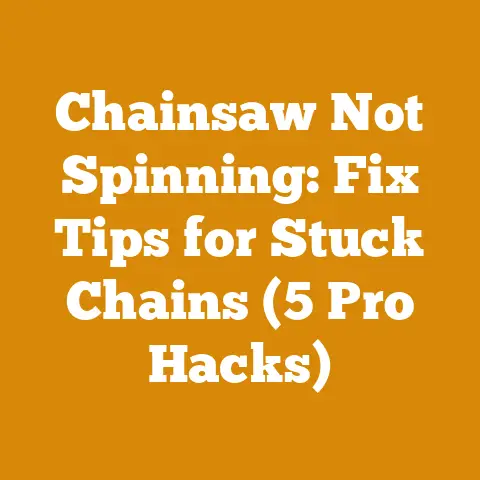Weed Trimmer with Blades (5 Pro Tips for Heavy Brush Cutting)
Did you know that the seemingly humble weed trimmer, when equipped with a blade, can tackle brush that would make Paul Bunyan himself raise an eyebrow? It’s a surprising truth, but harnessing this tool effectively requires more than just slapping on a blade and hoping for the best. Today, I’m diving deep into the world of weed trimmers with blades for heavy brush cutting, focusing on practical tips and, crucially, the often-overlooked costs involved. I’ll share my experiences, from battling overgrown blackberry bushes on my property to helping a friend clear a neglected woodland plot, and break down the financial implications, so you can make informed decisions and avoid costly mistakes.
Weed Trimmer with Blades: 5 Pro Tips for Heavy Brush Cutting (and the Costs You Need to Know)
Before we even discuss those pro tips, let’s acknowledge the elephant in the room: cost. Many people think a weed trimmer with a blade is a cheap alternative to a chainsaw or brush cutter. While it can be, underestimating the costs involved in both the equipment and the upkeep is a common pitfall. We’ll look at everything from the initial purchase price to long-term maintenance and even potential safety gear.
1. Choosing the Right Weed Trimmer and Blade: A Cost-Benefit Analysis
The first step is selecting the right tool for the job. Not all weed trimmers are created equal, and choosing the wrong one can lead to frustration, inefficiency, and ultimately, increased costs.
-
Weed Trimmer Power Source: You have three primary options: electric (corded or cordless), and gas-powered.
- Electric Corded: These are generally the cheapest upfront, often under $100. However, their limited range and power make them unsuitable for serious brush cutting. I made the mistake of trying to clear a patch of buckthorn with one years ago; it was a waste of time and energy. Think of them as light-duty tools for edging and trimming grass.
- Electric Cordless: These offer more mobility but come with a higher price tag, typically ranging from $150 to $400+. The key here is battery life and voltage. A 40V or higher model is recommended for heavy brush. Consider the cost of additional batteries, which can easily add another $100-$200 each. I’ve found that even with two batteries, larger projects can be a struggle. You’re constantly switching them out and waiting for them to charge.
- Gas-Powered: These are the workhorses of the weed trimmer world, offering the most power and runtime. Prices range from $150 to $600+, depending on the engine size and features. While the initial cost is higher, they often prove more cost-effective in the long run for heavy-duty tasks. The downside? Fuel costs, maintenance, and noise. I’ll delve into those in more detail later.
-
Blade Selection: The blade is just as crucial as the trimmer itself.
- Metal Blades: These are the standard for brush cutting. They come in various shapes and sizes, from simple two-tooth blades to more aggressive multi-tooth designs. Prices range from $10 to $50+ per blade. I’ve found that a good quality blade, even if it’s more expensive upfront, lasts longer and performs better, ultimately saving you money.
- Plastic Blades/Lines: Avoid these for heavy brush. They’re simply not durable enough and will break constantly, leading to frustration and wasted money.
- Brush Cutter Attachments: Some weed trimmers are designed to accept brush cutter attachments, which are essentially mini circular saw blades. These are ideal for tackling thicker brush and small saplings. Expect to pay $50-$150+ for a good quality attachment.
-
Cost Considerations:
- Initial Purchase: As mentioned above, the initial cost varies widely depending on the type of trimmer and blade.
- Fuel/Electricity: Gas-powered trimmers require gasoline and oil, while electric trimmers require electricity. According to the U.S. Energy Information Administration, the average price of gasoline in 2023 was around $3.50 per gallon. Depending on your usage, this can add up quickly. Electric trimmers are generally cheaper to run, but you’ll need to factor in the cost of electricity. My electric bill definitely sees a bump when I’m doing a lot of yard work.
- Maintenance: All weed trimmers require maintenance. Gas-powered trimmers need regular oil changes, spark plug replacements, and air filter cleanings. Electric trimmers require less maintenance, but you’ll still need to clean them and keep the battery terminals clean. Blade sharpening is also a recurring cost. I typically pay around $10-$15 per blade to have them professionally sharpened.
- Replacement Parts: Blades wear out, batteries die, and engines eventually need repairs. Factor in the cost of replacement parts when budgeting for your weed trimmer. I always keep a spare blade or two on hand, just in case.
- Safety Gear: This is often overlooked, but it’s crucial for protecting yourself. Safety glasses, gloves, and hearing protection are essential. I also recommend wearing long pants and a long-sleeved shirt to protect yourself from flying debris. A good pair of work boots is also a must. Expect to spend at least $50-$100 on safety gear.
Data Point: According to a survey by Outdoor Power Equipment Institute (OPEI), the average homeowner spends around $100 per year on lawn and garden equipment maintenance. This includes weed trimmers, lawnmowers, and other tools.
Personal Story: I once tried to save money by buying a cheap, off-brand weed trimmer from an online retailer. It broke down after only a few uses, and the replacement parts were impossible to find. In the end, I wasted my money and had to buy a more expensive, reputable brand. Lesson learned: sometimes, it’s better to spend a little more upfront to get a quality product that will last.
2. Proper Technique: Maximizing Efficiency and Minimizing Costs
Using the right technique can significantly impact the efficiency of your weed trimmer and reduce wear and tear on the machine, ultimately saving you money.
- Stance and Grip: Maintain a stable stance and grip the trimmer firmly with both hands. This will give you more control and reduce the risk of accidents.
- Swinging Motion: Use a smooth, sweeping motion to cut through the brush. Avoid hacking or chopping, which can damage the blade and put unnecessary strain on the trimmer.
- Cutting Angle: Angle the blade slightly downward to prevent it from bouncing off the brush. This will also help to direct the debris away from you.
- Working in Sections: Don’t try to clear everything at once. Work in small sections, gradually clearing the brush as you go. This will prevent the trimmer from overheating and reduce the risk of getting bogged down.
-
Avoiding Obstacles: Be aware of your surroundings and avoid hitting rocks, fences, or other obstacles. This can damage the blade and potentially injure you.
-
Cost Implications:
- Reduced Blade Wear: Proper technique reduces the wear and tear on the blade, extending its lifespan and saving you money on replacements.
- Increased Efficiency: Efficient cutting reduces the amount of time it takes to complete the job, saving you time and fuel/electricity.
- Reduced Maintenance: Avoiding obstacles and using the correct cutting angle prevents damage to the trimmer, reducing the need for repairs.
- Improved Safety: Proper technique reduces the risk of accidents, preventing costly injuries and potential medical bills.
Data Point: A study by The Journal of Agricultural Safety and Health found that improper use of lawn and garden equipment is a leading cause of injuries among homeowners.
Personal Story: I used to rush through brush-clearing projects, hacking away at everything in sight. I quickly learned that this was a recipe for disaster. I broke blades, damaged my trimmer, and even injured myself a few times. Now, I take my time, use the correct technique, and the results are much better. My equipment lasts longer, and I’m much safer.
3. Blade Maintenance: Sharpening and Balancing for Optimal Performance
A dull blade is not only less effective but also puts more strain on the trimmer, leading to increased fuel consumption and potential damage.
- Sharpening: Sharpen your blade regularly using a file or a grinder. A sharp blade will cut through brush more easily and efficiently. I typically sharpen my blades after every few uses, or whenever I notice them becoming dull.
- Balancing: An unbalanced blade can cause vibrations that can damage the trimmer and make it difficult to control. Check the balance of your blade regularly and re-balance it if necessary. This can be done using a blade balancer, which is a simple and inexpensive tool.
-
Cleaning: Clean your blade after each use to remove debris and prevent rust. This will help to prolong its lifespan.
-
Cost Implications:
- Extended Blade Lifespan: Regular sharpening and cleaning will extend the lifespan of your blade, saving you money on replacements.
- Improved Efficiency: A sharp blade cuts through brush more easily, reducing the amount of time and fuel/electricity it takes to complete the job.
- Reduced Maintenance: A balanced blade reduces vibrations, preventing damage to the trimmer and reducing the need for repairs.
- Improved Safety: A sharp, balanced blade is less likely to kick back or cause accidents.
Data Point: According to STIHL, a leading manufacturer of outdoor power equipment, sharpening your chainsaw chain regularly can increase its cutting efficiency by up to 20%. The same principle applies to weed trimmer blades.
Personal Story: I used to neglect blade maintenance, thinking it was a waste of time. I quickly learned that this was a costly mistake. Dull blades required more effort to use, and they wore out much faster. Now, I make blade maintenance a regular part of my routine, and it’s made a big difference in the performance and lifespan of my equipment.
4. Safety First: Investing in Protective Gear and Safe Practices
As I mentioned earlier, safety is paramount when using a weed trimmer with a blade. Investing in proper protective gear and following safe practices can prevent costly injuries and potential medical bills.
- Safety Glasses: Always wear safety glasses to protect your eyes from flying debris.
- Gloves: Wear gloves to protect your hands from cuts and abrasions.
- Hearing Protection: Wear hearing protection to protect your ears from the noise of the trimmer.
- Long Pants and Long-Sleeved Shirt: Wear long pants and a long-sleeved shirt to protect your skin from scratches and insect bites.
- Work Boots: Wear sturdy work boots to protect your feet and ankles.
-
Face Shield: Consider wearing a face shield for added protection, especially when cutting thick brush.
-
Safe Practices:
- Read the Manual: Always read the manufacturer’s manual before using your weed trimmer.
- Clear the Area: Clear the area of any obstacles or hazards before starting.
- Keep Bystanders Away: Keep bystanders at a safe distance while you’re working.
- Never Use in Wet Conditions: Never use your weed trimmer in wet conditions, as this can increase the risk of electric shock.
- Take Breaks: Take frequent breaks to avoid fatigue.
- Inspect Equipment: Before each use, inspect the equipment for any damage or wear.
-
Cost Implications:
- Prevention of Injuries: Proper safety gear and safe practices can prevent costly injuries and potential medical bills.
- Reduced Downtime: Avoiding injuries means less downtime from work or other activities.
- Peace of Mind: Knowing that you’re taking the necessary precautions can give you peace of mind while you’re working.
Data Point: The National Safety Council reports that lawn and garden equipment injuries result in thousands of emergency room visits each year.
Personal Story: I’ve had a few close calls while using a weed trimmer. Once, a rock flew up and hit my safety glasses, narrowly missing my eye. Another time, I tripped over a root and almost fell into a patch of poison ivy. These experiences have reinforced the importance of safety in my mind. I now make sure to wear all the necessary protective gear and follow safe practices every time I use my weed trimmer.
5. Budgeting and Cost Management: Tracking Expenses and Optimizing Spending
Finally, let’s talk about budgeting and cost management. Keeping track of your expenses and optimizing your spending can help you save money on your weed trimming projects.
- Track Your Expenses: Keep track of all your expenses, including the initial purchase price of the trimmer, fuel/electricity costs, maintenance costs, replacement parts, and safety gear.
- Set a Budget: Set a budget for your weed trimming projects and stick to it as closely as possible.
- Shop Around: Shop around for the best prices on equipment, parts, and supplies.
- Consider Used Equipment: Consider buying used equipment to save money.
- Do Your Own Maintenance: Learn how to do your own maintenance to save money on labor costs.
- Optimize Your Usage: Optimize your usage of the trimmer to reduce fuel/electricity consumption.
-
Plan Ahead: Plan your projects ahead of time to avoid costly mistakes.
-
Cost Implications:
- Reduced Spending: Budgeting and cost management can help you reduce your spending on weed trimming projects.
- Improved Financial Planning: Tracking your expenses can help you improve your overall financial planning.
- Increased Savings: Saving money on weed trimming projects can free up funds for other things.
- Greater Control: Taking control of your finances can give you a greater sense of control over your life.
Data Point: A survey by Consumer Reports found that homeowners who budget for lawn and garden expenses spend an average of 15% less than those who don’t.
Personal Story: I used to be terrible at budgeting. I would just buy whatever I needed without thinking about the cost. As a result, I often overspent and ended up in debt. Now, I make a budget for everything, including my weed trimming projects. This has helped me save money and get my finances under control.
Breaking Down the Costs: A Hypothetical Example
Let’s consider a hypothetical example to illustrate the costs involved in using a weed trimmer with a blade for heavy brush cutting.
Scenario: You need to clear a 1/4-acre plot of land overgrown with brush and small saplings.
Equipment:
- Gas-Powered Weed Trimmer: $300
- Brush Cutter Blade: $30
- Safety Glasses: $15
- Gloves: $10
- Hearing Protection: $20
- Work Boots: $80
Total Equipment Cost: $455
Recurring Costs:
- Gasoline: $10 per gallon (estimate 5 gallons for the project) = $50
- Oil: $5 per quart (estimate 1 quart for the project) = $5
- Blade Sharpening: $15 (assuming one sharpening is needed) = $15
- Replacement Blade (optional): $30
Total Recurring Costs: $100 (or $130 with replacement blade)
Labor:
- Your Time: Let’s say it takes you 20 hours to complete the project. Even if you’re not paying yourself an hourly wage, consider the opportunity cost of your time. What else could you be doing with those 20 hours?
Total Project Cost:
- Equipment: $455
- Recurring Costs: $100 (or $130)
- Labor: (Opportunity Cost – Variable)
Total: $555 – $585 + Opportunity Cost of Time
Key Takeaways from the Example:
- Initial Investment: The initial investment in equipment is significant.
- Recurring Costs: Recurring costs like fuel, oil, and blade sharpening can add up over time.
- Labor Costs: Your time is valuable. Consider the opportunity cost of your time when deciding whether to tackle a project yourself or hire someone else.
- Unexpected Costs: Be prepared for unexpected costs, such as replacement parts or additional fuel.
The Cost of Neglect: Why Proper Maintenance Pays Off
I want to emphasize the cost of neglecting your weed trimmer. I’ve seen firsthand how a lack of maintenance can lead to expensive repairs and premature equipment failure.
- Clogged Air Filter: A clogged air filter restricts airflow to the engine, causing it to run inefficiently and potentially overheat. This can lead to engine damage and costly repairs. Replacing an air filter is a simple and inexpensive task, but neglecting it can lead to much bigger problems.
- Dirty Spark Plug: A dirty spark plug can cause the engine to misfire, reducing power and fuel efficiency. Replacing a spark plug is another simple and inexpensive task, but neglecting it can lead to engine damage.
- Old Fuel: Old fuel can gum up the carburetor and fuel lines, causing the engine to run poorly or not at all. Always use fresh fuel and store your weed trimmer properly when not in use.
- Loose Bolts and Screws: Loose bolts and screws can cause vibrations and damage to the trimmer. Check your trimmer regularly for loose fasteners and tighten them as needed.
The Bottom Line: Proper maintenance is essential for prolonging the lifespan of your weed trimmer and preventing costly repairs. Take the time to clean, sharpen, and lubricate your trimmer regularly, and it will reward you with years of reliable service.
Alternative Solutions: When a Weed Trimmer Isn’t Enough
While a weed trimmer with a blade is a versatile tool, it’s not always the best solution for heavy brush cutting. In some cases, it may be more cost-effective to use a different tool or hire a professional.
- Chainsaw: A chainsaw is a more powerful tool that can handle thicker brush and small trees. However, chainsaws are also more dangerous and require more skill to operate safely. The costs involved with a chainsaw are significantly higher including the chainsaw itself, safety equipment such as chaps and helmet, fuel, bar oil, and regular chain sharpening.
- Brush Cutter: A brush cutter is a specialized tool designed specifically for cutting heavy brush. Brush cutters are more powerful and durable than weed trimmers, but they are also more expensive.
- Professional Land Clearing Services: If you have a large area to clear or the brush is particularly thick, it may be more cost-effective to hire a professional land clearing service. These services have the equipment and expertise to clear land quickly and efficiently. Costs for professional land clearing services vary widely depending on the size and scope of the project.
Data Point: According to HomeAdvisor, the average cost of land clearing services ranges from $500 to $2,500 per acre.
Making the Right Choice:
The best choice for you will depend on your specific needs and budget. Consider the following factors:
- The Size and Density of the Brush: If you only have a small amount of light brush to clear, a weed trimmer with a blade may be sufficient. However, if you have a large area to clear or the brush is particularly thick, you may need a more powerful tool or professional help.
- Your Skill Level: Chainsaws and brush cutters require more skill to operate safely than weed trimmers. If you’re not comfortable using these tools, it’s best to hire a professional.
- Your Budget: The cost of equipment and labor can vary widely. Consider your budget when deciding which option is best for you.
Global Perspectives: Weed Trimmer Costs Around the World
It’s important to remember that the costs of weed trimmers and related services can vary significantly depending on your location.
- Developed Countries (e.g., United States, Canada, Europe): In developed countries, labor costs are generally higher, but equipment is often more affordable.
- Developing Countries (e.g., India, Brazil, Africa): In developing countries, labor costs are generally lower, but equipment may be more expensive due to import duties and other factors.
Example: In the United States, you might pay $300 for a high-quality gas-powered weed trimmer. In India, the same trimmer could cost $400 or more. Conversely, you might pay $50 per hour for labor in the United States, while in India, you might only pay $10 per hour.
Adapting to Local Conditions:
When budgeting for weed trimming projects, it’s important to research the local costs of equipment, labor, and supplies. This will help you create a more accurate budget and avoid overspending.
Actionable Takeaways: Your Next Steps
So, what are the key takeaways from all of this? Here’s a summary of the actionable steps you can take to make informed decisions and save money on your weed trimming projects:
- Assess Your Needs: Determine the size and density of the brush you need to clear and choose the right tool for the job.
- Shop Around: Compare prices on equipment, parts, and supplies from different retailers.
- Invest in Quality: Buy quality equipment that will last and perform well.
- Prioritize Safety: Invest in proper safety gear and follow safe practices.
- Maintain Your Equipment: Clean, sharpen, and lubricate your trimmer regularly.
- Track Your Expenses: Keep track of all your expenses and set a budget.
- Consider Alternatives: Explore alternative solutions, such as chainsaws, brush cutters, or professional land clearing services.
- Research Local Costs: Research the local costs of equipment, labor, and supplies in your area.
- Plan Ahead: Plan your projects ahead of time to avoid costly mistakes.
- Don’t Underestimate Your Time: Consider the opportunity cost of your time when deciding whether to tackle a project yourself or hire someone else.
By following these steps, you can effectively manage the costs of your weed trimming projects and achieve your goals without breaking the bank.
Final Thoughts: A “Cord”ial Farewell (Pun Intended!)
Weed trimmers with blades can be powerful tools for managing heavy brush, but it’s crucial to approach these projects with a clear understanding of the costs involved. From selecting the right equipment to prioritizing safety and implementing proper maintenance, every decision you make can impact your budget. By taking the time to plan, research, and manage your expenses effectively, you can conquer even the most challenging brush-clearing tasks without getting tangled in financial weeds. Now, get out there, be safe, and make those weeds tremble!






